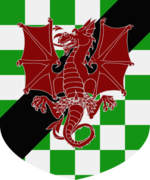Njombia
From Dragon Eye Atlas
| Official Name | Kingdom of Njombia |
| Capital | Buikwiban |
| Government | Monarchy |
| Population | 2,711,000 |
| Dominant Race | human |
| Dominant Culture | Kiswaili |
| Dominant religion | Kiswaili Faith |
| Flag | 
|
Njombia is a tight-knit realm at the western coast of Auseka. It has its own religion and culture which has spread into Palan and Hanzatia, but in Njombia, all is one - politics, culture, faith.
Njombia has a bit of everything - it stretches through all climate zones that Auseka has to offer, it borders elven, dwarven and human realms, including the huge Vericum and the magic realm of Palan.
While formally a monarchy, the tribal structures that dominate the area for millenia have not been entirely replaced. Family and clan memberships are important and the individual provinces of the realm are often inhabited by people forming a tribe or clan. They are not generally hostile to foreigners, but business and political relations are an order of magnitude more common among tribe members than with outsiders.
Politics
While nominally the head of the state, the king of Njombia has limited actual power, which depends much more strongly on his own land ownership, alliances and the respect he commands among the nobles than upon the title. Throughout the history of the realm, there have been strong kings and weak kings.
The feudal hierarchical titles within Njombia are:
- King
- Principal (responsible for a province)
- Protector (responsible for parts of provinces, strongholds or cities)
- Chief (responsible for a village, city quarter or small area of lesser populated land)
Note that there is no equivalent of the unlanded knight within Njombia, as nobility and land ownership go together. The Chief is the lowest noble rank, and the closest equivalent to the knight in other realms, as his domain barely affords him a horse and armour, in many poorer regions the Chief cannot afford a full plate armour.
On the local level, the tribal structures govern local affairs in a semi-democratic way. Generally, all adult males (and in the north, married women as well) have a say in the matters of the village or area, and meet in what is often simply called a gathering to discuss and decide the question at hand. For regional matters, the chief will then be sent with the local decision to partake in a larger gathering where all the chiefs discuss and come to a solution. Only rarely does the Protector need to resolve a stalemate by adding his authority to one side or the other.
As a country, Njombia is torn between a tribal society and a centralized state and has elements of both. It is clearly an area in the middle of change, and the change doesn't always go into the same direction. In fact, borders between provinces are more fluent than a map can do justice for, as they depend more on tribe affiliation than on landmarks. A village belongs to a province because most of its members belong to the tribe that governs that province. If, through births, migration, famine or war these factors change, so does the allegiance of the place. In fact, many settlements on the borders of provinces which have a mixture of inhabitants are considered an "inbetween" and are jointly governed or have overlapping jurisdictions, each tribal principal ruling his subjects.
The tribal nature of Njombia also results in occasional feuds and strife within the realm. While these can often be solved with minimal bloodshed through small, symbolic encounters or ritual battles with fixed rules, every decade or so a major conflict between two provinces/tribes flares up.
Laws
Njombia has a relatively thin set of laws, governing only serious crimes. All other disputes are resolved according to tradition or with the help of an arbiter, either a priest or the head of a tribe, as an impartial mediator.
This page is still incomplete and missing content or details that are planned, but have not been added yet.
Population
The population of Njombia is as varied as the lands, and has considerable numbers of non-human races, too. Elves are the lowest in number, but can be found all over the realm. The tribal structure of Njombia fits well to integrating tribes of elves, and as a result there are tribes of elves living in the forests all over Njombia, though in total they make up less than one in twenty of the people. Gnomes are more common, especially in the towns and cities, making up a bit less than one in ten, while dwarves number around the same as that, but are more concentrated, living in the mountainous areas in the north, south and along the eastern border.
In total, around 20% of the population is non-human, making Njombia the most racially diverse realm in Auseka. Of course, there are still plenty of villages where not a single non-human can be found, but in the towns and cities, the diversity is very visible, with dwarven and gnomish quarters and businesses everywhere.
Economy
This page is still incomplete and missing content or details that are planned, but have not been added yet.
History
This page is still incomplete and missing content or details that are planned, but have not been added yet.